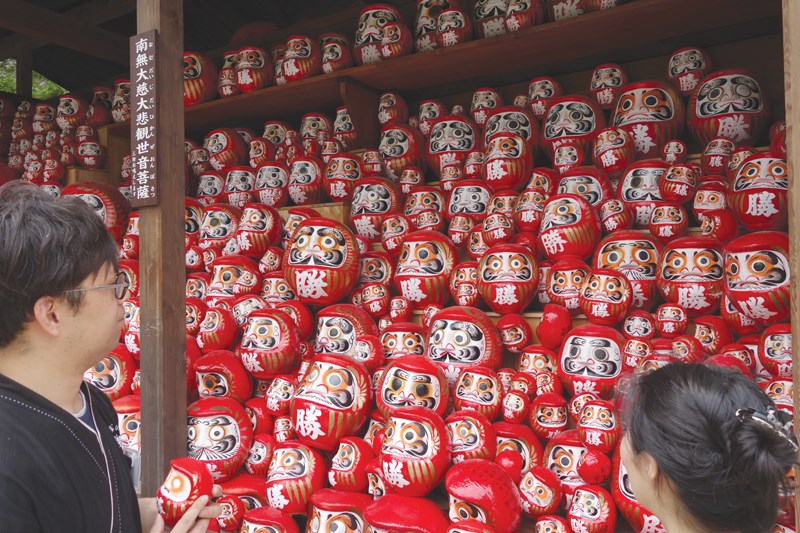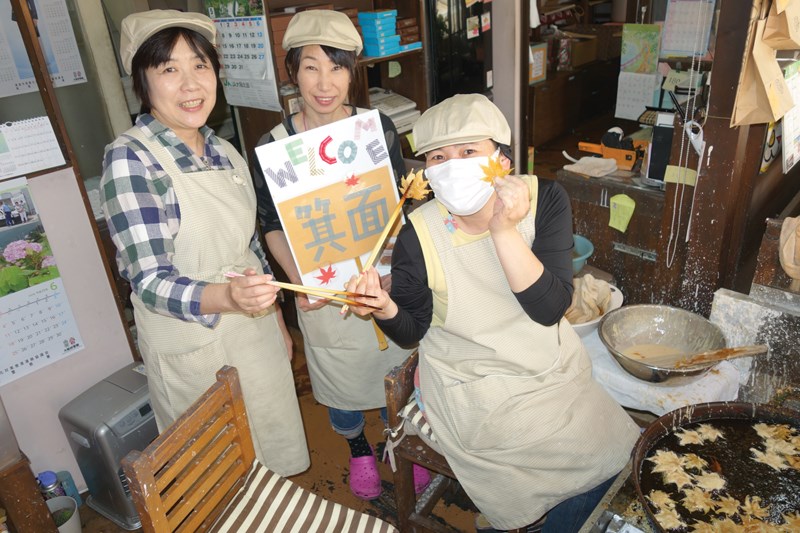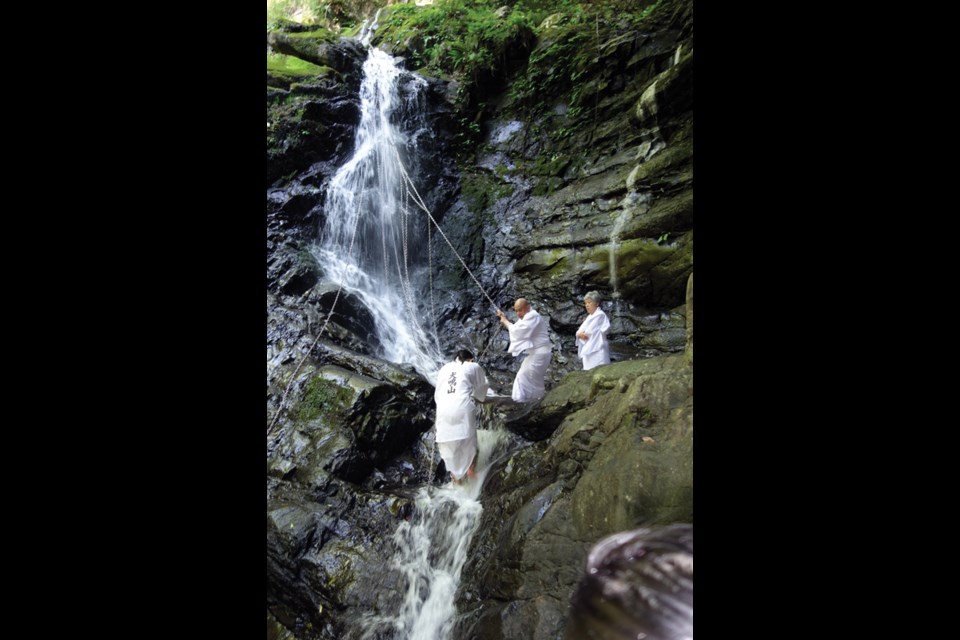You get to eat Canada’s national emblem when you visit Osaka’s Minoh suburb and the Meiji no Mori Mino Quasi-National Park.
As you start the 40-minute walk up into the park, before you leave the town area you can watch several local shops deep-frying small maple leaves in sweet batter to create maple leaf tempura, a popular tourist treat. The maple leaf’s fall colours are a major attraction.
Welcome to the Osaka you never knew existed. Please expect – and be delighted by – the unexpected.
Especially during my exploration of the Osaka Prefecture countryside, I rarely saw any other westerners. But the Japanese were always helpful, even if they couldn’t speak much English.
Focusing on the “local is fascinating” theme, I stayed in four ryokan-onsen hot springs Japanese-style hotels.
Takeaway tips: Never wear shoes in most indoor areas; watch what other people do. But you can wear the provided yukata – a light cotton kimono – everywhere inside the ryokan.
Your room usually has its own basin and wash toilet (the diagrams are fairly clear even if the instructions are in Japanese; some toilets offer a “blow dry” feature, others light up, most have a heated seat – and toilet paper is always provided as a default option).
Unless you have a private shower and tub, you wash in public, separate male-female communal shower areas (some don’t allow tattoos) before soaking in communal hot springs indoor and outdoor baths.
Breakfast and dinner are included – usually served in your room although breakfast, especially if it’s a buffet, is normally in a common dining room. The food is mostly Japanese meat-fish-veg-soup-rice in small, often unfamiliar but tasty dishes.
You sleep on a futon bed made up every night on the tatami (straw) matting floor.
Remember to bow very frequently whenever you meet or leave people; regularly repeat “thank you very much” Arigatou gozaimasu (go-zigh’-ee-mas – the “u” is silent); don’t tip.
Minoo Sanso Kazenomori, in the north, offered an amazing view over Osaka – especially when the lights came on at night, a shuttle bus into the nearby town of Minoh and an easy hike to a waterfall while you nibble on those tasty maple leaves.
Nanten-en, in the south, had a very countryside train platform and provided a descriptive English menu for its 13-course dinner; I was allowed to use the suite’s private hot springs bath.
Minamitei provided a room with its own shower and hot springs-fed tub – and invoked a feeling of rough-and-ready history with its instruction not to gamble in the corridors, or have “highly inflammable items like gunpowder” or “guns or swords prohibited by law” in the room.
Fudoguchikan had very welcoming staff, including an enthusiastic server at the breakfast buffet, ready to cater to your every wish – and offered a choice of food items for dinner on the second evening, the only place that did.
But when I set off for that so-called meditation at the Inunakisan-Shipporyuji Temple, at Mt. Inunaki in the southern Osaka countryside, it turned out to be a steep ropes-and-chains 558-metre climb up to a temple over loose rocks, slippery leaves and twisted roots, and then being hung head-first over the edge of a precipice.
Supported by a special thick rope wrapped around two people, the visitor is slowly lowered over the edge until they are hanging head down over the gorge = nosoki shugyo (literally “peek training”…peek at the 100m drop) as they shout “yes” to the monk’s questions whether they will be good to family, co-workers, and humanity, before being hauled back up.
After our descent, we used chains again to scale a steep, slippery waterfall for a special blessing.
What did it all feel like? Challenging, rewarding, a wonderful combination of the physical, intellectual, emotional and spiritual – all in a nature setting in a foreign country. Unforgettable.
Once again going local and with few others in sight, I visited the 1,300-year-old Katsuo-Ji Temple – known as the “temple of the winner’s luck” – in a forested hillside near Minoh City.
This is where people go to pray for success in any number of personal endeavours (school, business, health, sports, arts, etc.).
Having gone public (if only to yourself) with your winning aim – perhaps with the purchase of a “daruma” (tumbling doll), and especially if you choose a large one on which you write your name, address, next age and your winning goal – “everything then depends on how much you can win for yourself,” according to our guide – in other words, how much effort you will put into the project.
Here’s one indication that an attraction is very local: The TripAdvisor reviews will probably be mostly if not all in the local language. Google does make an effort to translate so you can still get some idea of what’s on offer.
And that’s exactly the case at southern Osaka’s Tajiri Ocean Community Centre, parent of the Tajiri Port Sunday Morning (mostly seafood) Market, which runs every Sunday 7 a.m. to noon and where local fishermen sell what they have just caught.
You can also take a 90-minute trip on a working fish boat out into Osaka Bay where you help haul up the nets to see what has been caught – like octopus, squid, sea cucumber and eel.
Back on shore the fishermen then clean your catch for you to cook in the barbecue pits provided, supplemented by a seafood-plus platter from the restaurant in the complex.
That day, to reinforce the spring-summer Japanese mood, I was driven around in the latest model – it hadn’t even been officially released – seven-seater Honda stepwagon: It had a specially designed and prominent cherry blossom decoration on both sides and the back plus a tatami-themed interior. Orix Rent A Car wants visitors to feel they are truly in Japan, so with each rental also includes an amenity kit of various Japanese items useful for visitors.
For a bit more Osaka culture I said, yes, to a Noh experience at the Yamamoto Nohgakudo Theatre. The attraction: Audiences know the stories but come to see how well the actors portray the characters and express their emotions.
I was kindly given a tour by Yoshie Yamamoto, the manager, and had the good fortune to meet a living treasure Noh drum player who showed me how to hold and hit a drum.
But my luck failed when a Noh actress showed us six masks (“Man or woman? How old?” – I scored only two out of six) and demonstrated how holding them at different angles conveyed different emotions and feelings – for example, up = happy, down = sad.
Next, once again the only Westerner, off I went to see Osaka’s Orix Buffaloes baseball team “play ball!” in the 36,000-seat Kyocera dome. Polite applause followed almost every play – while cheering and shouting erupted for good hits and popular players.
Hiroshi Mizohata, president of the Osaka Convention & Tourism Bureau – resplendent in his gold lame jacket “because it personifies Osaka’s shining image, Japan’s rising sun and wealth in general” – cited the need to promote tourism to counter the country’s ageing and declining population.
“Osaka shares Japan’s attractions – safe, clean, nature, history, variety – and adds its own appeal: culture, entertainment, sport, food and a welcoming environment because most people grew up here and are proud of Osaka,” says Mizohata, Japan’s former Tourism Commissioner.
Susumu Okubo, 42, Chef de Cuisine of the Pierre Restaurant on the 20th floor of the InterContinental Hotel Osaka was recently awarded its first Michelin star.
Inspired by nature and the seasons, Chef Okubo says he has loved cuisine since he was a child, and always admired French culture. So he spent time travelling in France, immersing himself in the culture and food, enabling him to blend French cooking techniques with Japan’s best seasonal produce.
One of Chef Okubo’s prized signature dishes – “a six-course feast of cuts from tongue to tail of highest quality Wagyu beef of signature olive-fed beef” – comes from cows that have eaten the olive residue after the oil-pressing, beef that is not readily available otherwise. The emphasis is on combinations of flavour and appearance/presentation.
But let’s not forget the humour: Hearing I liked uni (sea urchin), the chef included on our amuse-bouche/hors d’oeuvre a thin slice of olive-fed beef wrapped around uni and covered with a little pastry cow.
I left one of the top Osaka attractions to the last when I checked into the Hotel New Otani, across from Osaka Castle.
When you are travelling, it helps to have a place to stay that is close to at least one of the major attractions in the area.
With a bit of advance planning, you will not only be able to stroll over to the castle and its grounds but also see it from your room. Of Hotel New Otani’s 525 guest rooms, 294 (try for one on a higher floor) have a view of the castle – prominently rising above Osaka Castle Park, fortification walls, leafy trees and three waterways. The castle is even more spectacular when brightly lit at night.
Yes, here I did see a few other westerners. But I felt I had experienced so much of the real Japan – the sense of tradition, that everything has a place and a reason, the pride in work and most important the mutual respect – things that really mattered even if I hadn’t learned how to say much more than Arigatou gozaimasu.
If you go:
The Osaka Convention & Tourism Bureau has excellent local attraction and accommodation suggestions at osaka-info.jp.
For the “waterfall meditation” challenge, go to inunakisan.jp and look for the envelope symbol to send an email to reserve/register and receive information in English.
Longtime News personal finance columnist and travel writer Mike Grenby teaches journalism at Bond University on Australia’s Gold Coast – mgrenby@bond.edu.au.






